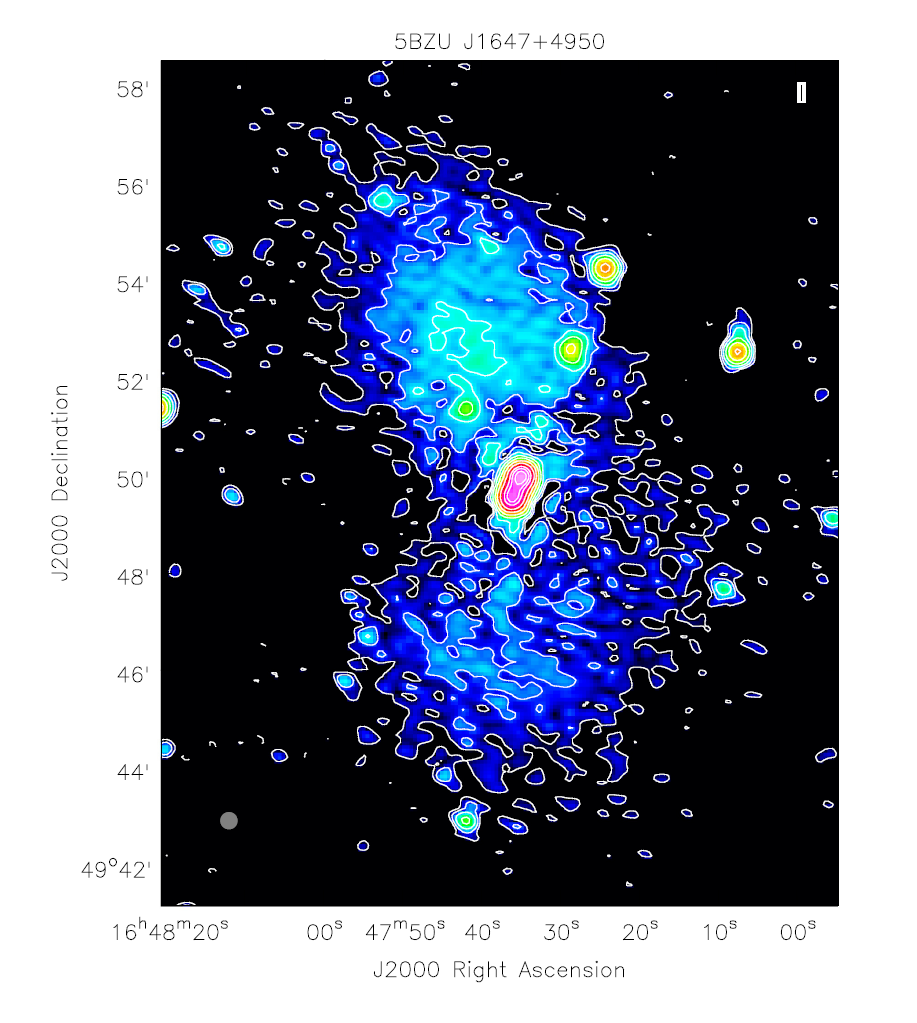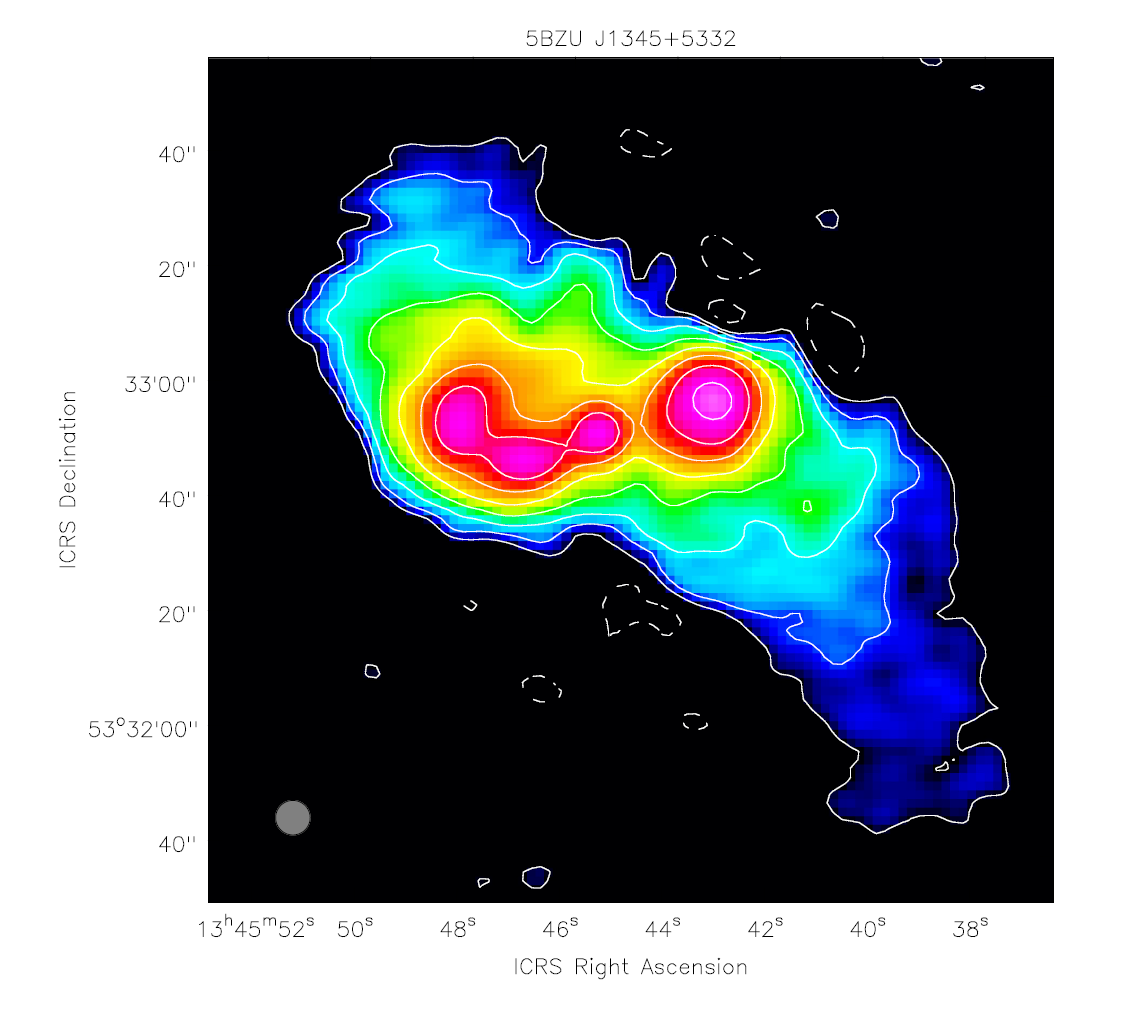Astronomy Object of the Month: 2022, December
< previous Archive next >
Twisted blazars
Astronomers from the Jagiellonian University Astronomical Observatory, with the help of dedicated and archival data from the European radio
interferometer LOFAR, report a group of active galaxies with unexpected, extensive radio structures. Their analysis may provide new insight into past activity cycles of supermassive black holes residing at their centres.

Illustration 1: Radio image of blazar catalogued as 5BZU J1647+4950. The observations are from the LOFAR array.
Thanks to the very high sensitivity of the instrument, a huge radio structure can be seen here, resembling two jagged lobes, measuring about 3 million light years
(equivalent to about 2.5 x 1019 km)! At the heart of the object resides a supermassive black hole, and the emission associated with its consumption of infalling matter is evident, among others, in the form of a bent radio jet, visible as an elongated, intense structure at the very centre of the map. In this case, the jet is pointing in our direction. The grey circle in the lower left corner of the map indicates the resolving power of the observation.
Credit: The Authors
Active galaxies (ang. Active Galactic Nuclei; AGNs) are a specific group of sources that we can observe in the sky. They emit huge amounts of energy as their inner 'engines' are supermassive black holes residing in their centres (with masses in the order of millions or even billions of solar masses), powered by the matter accreting onto them. Sometimes, jets are also formed near the poles of the black holes – dense flows of matter and radiation that spread far beyond the galaxy itself, forming huge and radio-luminous lobes. Such structures are usually observed as so-called radio galaxies, whose jets are visible in the plane of the sky.
A special class of active galaxies are blazars, in which one of the jets is directed towards the Earth. For this reason, they are most often visible to us as very compact radio sources. However, thanks to modern telescopes observing the sky at long wavelengths, it is possible to observe blazars that are different from this description as they possess very extensive structures. Such objects have been observed with the European LOw Frequency ARray (LOFAR) interferometer at wavelengths of roughly two metres. They have very strong and compact radio centres, jets of tens of thousands of light years in length light years, and extended structures that in extreme cases reach millions of light years in length.
Pictured in Illustration 1 is blazar 5BZU J1647+4950 along with its massive structure, discovered by the authors of the discussed work. The panel shows the entire object, exhibiting radio structure resembling two radio lobes measuring about 3 million light years in the projection on the sky. This is almost as much as the entire distance separating the Milky Way from the Andromeda Galaxy!

Illustration 2: Radio image of blazar 5BZU J1345+5332 observed with the LOFAR telescopes network. At the very centre of this object lies a supermassive black hole. It is most likely that the two opposing jets are undergoing precession, and so the extensive radio emission takes the form of the S-shaped letter. The grey circle in the lower left corner of the map indicates the resolving power of the observation.
Credit: The Authors.
The origin of such structures can be explained by the specific activity cycle of the host object. If the galaxy collides with another galaxy during its existence, and at the same time its supermassive black hole collides with another supermassive black hole, a change in the direction of the jets' propagation may occur, and/or their multiple emission. The former activity of the galaxy will leave a trace on the sky in the form of large, faint and old radio structures that lies in a different direction to the present AGN emission (i.e. radio jets).
Jets can also be precessing, forming S-shaped structures. An example of such blazar is visible on Illustration 2. In this case, we can observe two bent (precessing) jets, forming extensive but much fainter radio lobes.
The aim of further research will be to estimate the exact physical parameters of these structures, such as the strength of their magnetic field and their age.
Original publication: Pajdosz-Śmierciak U., Śmierciak B. i Jamrozy M., Possible jet reorientation in low-frequency radio structures of blazars, MNRAS, 512, 2122 (2022).
The research was carried out in the Radioastronomy and Space Physics of the Jagiellonian University’s Astronomical Observatory (OA UJ). They were obtained with the financial support of the National Science Centre under grant 2018/29/B/ST9/01793. The maintenance of the Polish LOFAR stations is financed by the Ministry of Education and Science.
|
Urszula Pajdosz-Śmierciak Astronomical Observatory Jagiellonian University Urszula.Pajdosz [at] uj.edu.pl |


